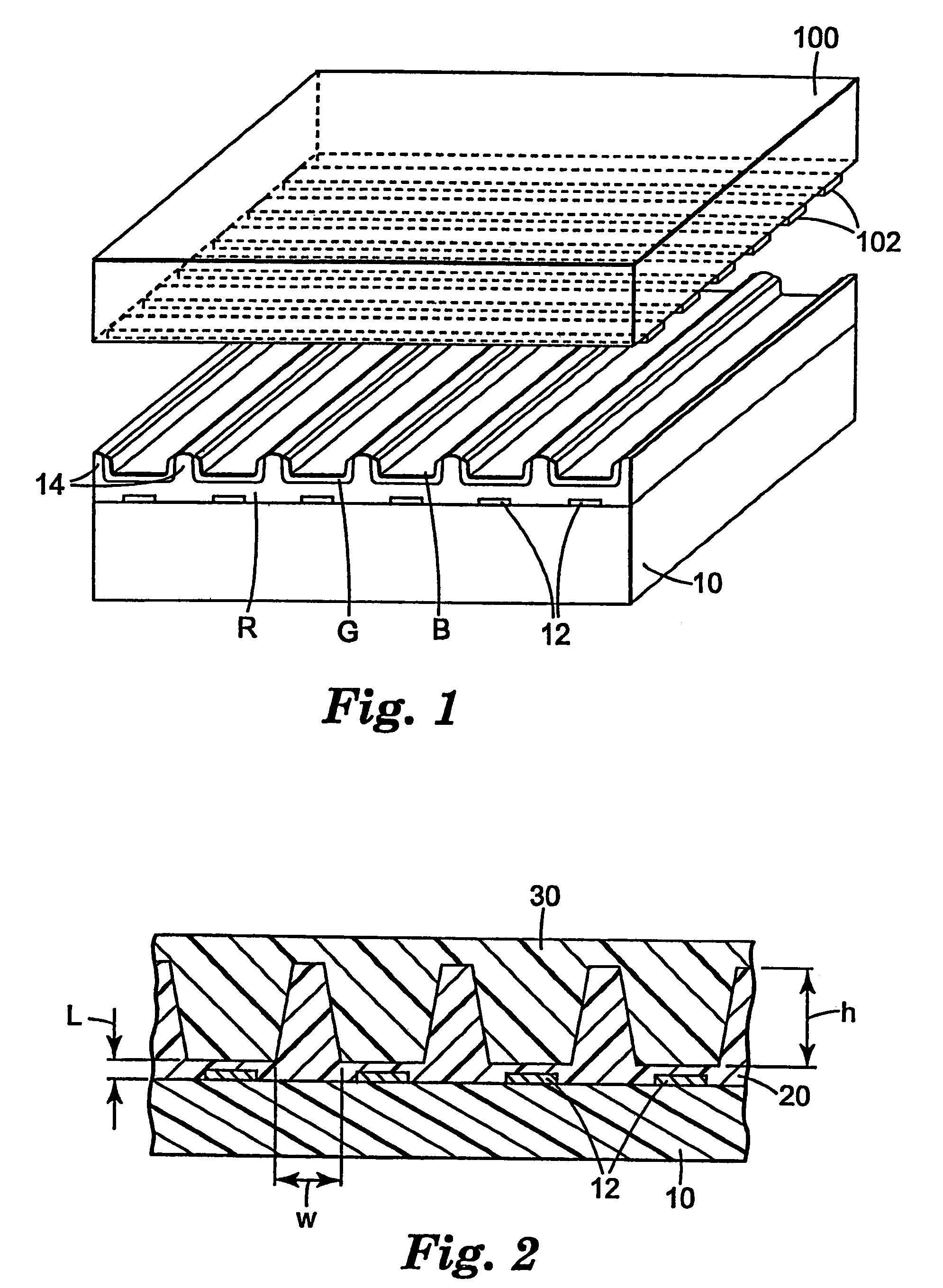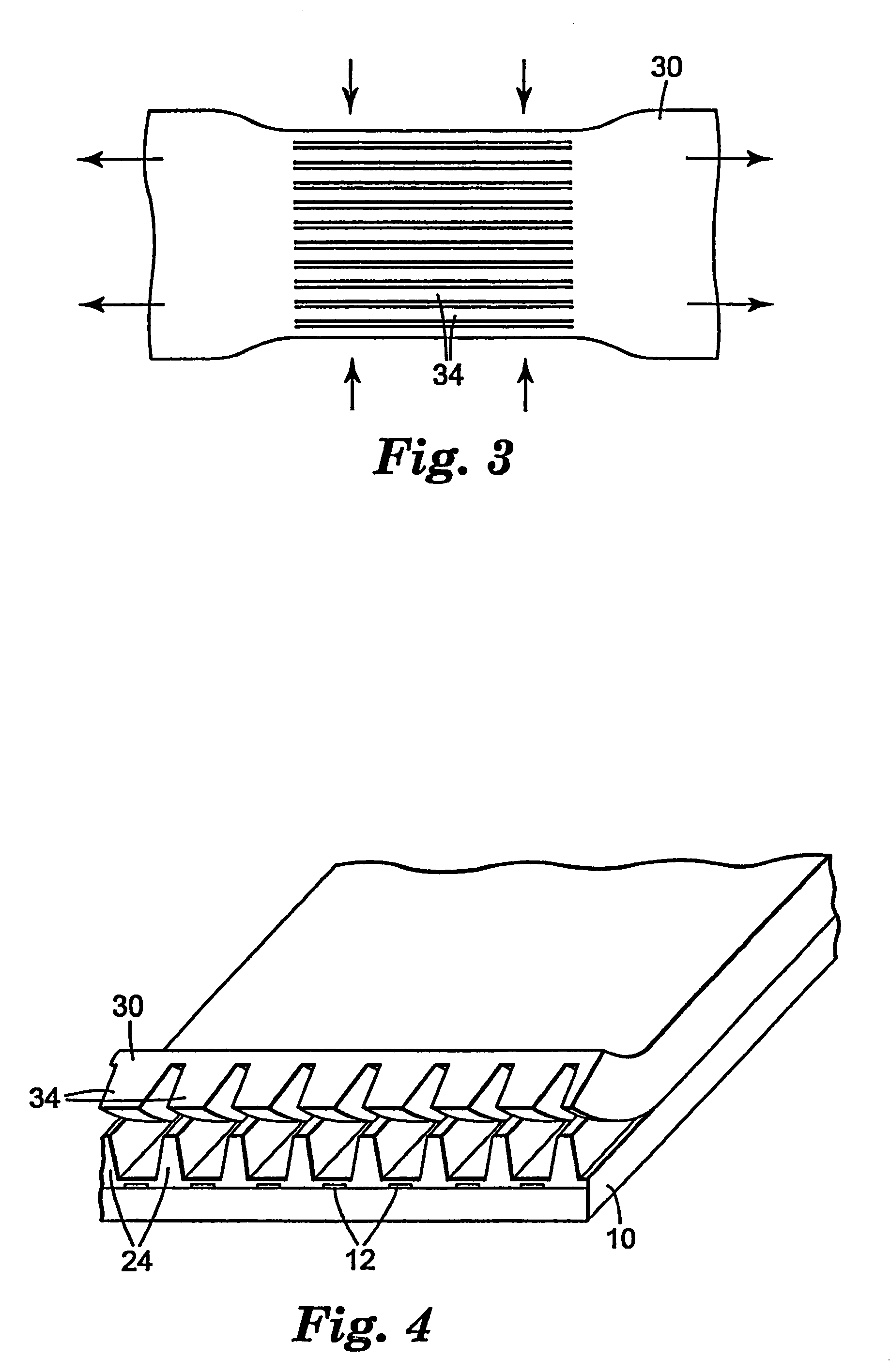Method for precise molding and alignment of structures on a substrate using a stretchable mold
a technology of stretchable molds and structures, applied in the manufacture of electrode systems, cold cathode manufacturing, electric discharge tubes/lamps, etc., can solve the problems of difficult alignment across the substrate, the method is prone to elongation, and the method has the same disadvantages
- Summary
- Abstract
- Description
- Claims
- Application Information
AI Technical Summary
Benefits of technology
Problems solved by technology
Method used
Image
Examples
examples 1 and 2
[0083]In the examples which follow, a jig was built to stretch a sheet of a polymer mold as shown in FIG. 7. To stretch a sheet of a polymer mold, S, the sheet was gripped at points A and B. Lateral force (in the plane of the mold) was then applied by turning a fine thread screw, C. The jig was designed to fit under a toolmaker microscope to observe the pattern of the polymer tool while stretching. Polymer mold pitch measurements were taken at various strain levels. Free-state pitch measurements were made before and after stretching to determine whether the levels of strain applied had caused plastic or elastic deformation. The polymer molds were about 2.5 cm wide and about 15 cm long.
example 1
[0084]A polymer mold with V-groove microstructures was used. The polymer mold was a flat PET film onto which an acrylate material was cast and cured to form V-groove microstructures. The PET film was nominally 127 μm thick and the microstructure bearing acrylate layer was about 27 to 30 μm thick. In the free state, the V-groove structures were measured to be 49.556 μm apart from peak to peak.
[0085]As described above, the polymer mold was secured onto the jig to stretch in a direction parallel to the V-grooves. The V-groove spacing, or pitch, was measured at various levels of strain by visual inspection under a toolmaker microscope at 200× magnification. The results are summarized in Table 1. Loading conditions were indicated by the number of turns of screw C.
[0086]
TABLE 1Loading conditionPitch (μm)free state49.556pre-load (0 turns)49.5300.2549.5200.5049.5100.7549.5001.0049.4831.2549.4701.5049.463post-load (0 turns)49.530
[0087]The spacing of the microstructured grooves was affected b...
example 2
[0088]The same procedure as in Example 1 was repeated for a polymer mold having a different construction and a different pattern. In this example, the mold had rectangular channels and was a monolithic structure made entirely of polycarbonate, one surface of which was smooth and the other surface of which had the rectangular channels. The entire mold was 550 μm thick and the channels were 198 μm deep. The channels were nominally 120 μm in width and were spaced 219.94 μm apart. S strain was applied parallel to the channels in the plane of the polymer tool. The pitch measurements are summarized in Table 2.
[0089]
TABLE 2Strain (%)Pitch (μm)pre-load (0%)219.870.161219.740.342219.590.491219.45post-load (0%)219.87
[0090]Similarly to Example 1, fine control of the feature pitch spacing was demonstrated by controlled stretching of the polymer mold. Again, as much as 1900 ppm of shrinkage in the pitch of the channels was obtained by elastically stretching the mold. Furthermore, the pitch of th...
PUM
| Property | Measurement | Unit |
|---|---|---|
| height | aaaaa | aaaaa |
| temperature | aaaaa | aaaaa |
| temperature | aaaaa | aaaaa |
Abstract
Description
Claims
Application Information
 Login to View More
Login to View More - R&D
- Intellectual Property
- Life Sciences
- Materials
- Tech Scout
- Unparalleled Data Quality
- Higher Quality Content
- 60% Fewer Hallucinations
Browse by: Latest US Patents, China's latest patents, Technical Efficacy Thesaurus, Application Domain, Technology Topic, Popular Technical Reports.
© 2025 PatSnap. All rights reserved.Legal|Privacy policy|Modern Slavery Act Transparency Statement|Sitemap|About US| Contact US: help@patsnap.com



